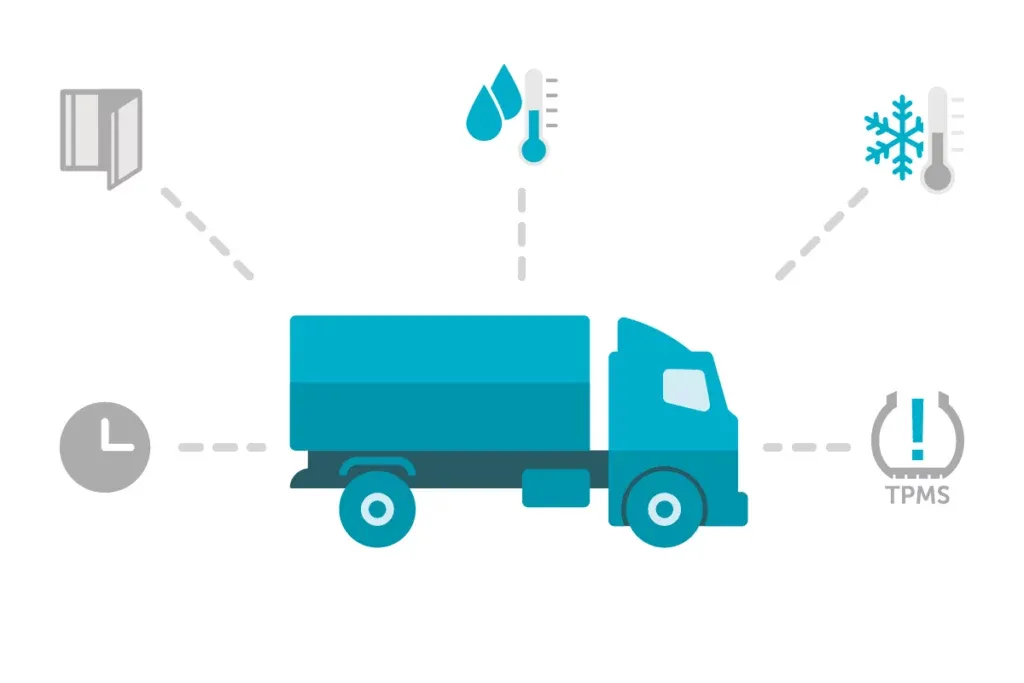We collect a large variety of data from vehicles and drivers. On this page, we list the most important data we collect.

Basic Telematics Dataset
Our basic telematic dataset is based on a so-called “trip”; a complete log from the moment a vehicle is turned ON until it’s turned OFF again. A trip consists of multiple records with:
- GPS timestamp
- GPS speed
- GPS direction
- Vehicle status (Ignition ON/OFF)
- Odometer value*
- Power voltage
- Number of satellites
- GPS Signal
- GSM Signal
- Event (eg. power disconnection)
- Digital I/O status (ON/OFF)** – requires optional connection
- RPM – only when connected to CAN-bus
- Fuel usage – only when connected to CAN-bus
- Trip status (Business/Private) – with optional switch
- Driver ID – with optional ID-reader
Optional data from the built-in accelerometer
- Harsh acceleration
- Harsh braking
- Harsh cornering
Per trip, we register the following data:
- Date
- Time
- Location when turned ON
- Location when turned OFF
- Time spent on location
- Total time
- Driving time
- Idle time (vehicle is turned ON, but no movement is detected)
- Distance traveled
- Speed graph
- Accelerometer excesses
* By standard we collect the real odometer value from the CAN-bus. If this parameter is not available, we use a virtual odometer value.
** If certain I/O’s are connected and configured, they will be logged separately.
Dynamic Logging: Enhanced accuracy
To ensure the highest accuracy in logging trips, we use a self-developed featured called “Dynamic Logging”. Read more
Basic EV dataset
- Odometer / vehicle mileage
- Ignition / Switched Power Supply
- Charger Connected / CPP
- Charging
- State Of Charge (SoC)
- Electric Consumption Average
- Range Electric
- Remaining Charging Time
- State Of Health (SoH)
- A/C
- Vehicle Locked
- Door FL
- Door FR
- Door RR
- Door RL
- Door Trunk
- Reverse gear (on/off, value)
- Brake
- Speed
- Acceleration
- Start battery
- Maintenance (Mileage to service)
- Regenerative braking
- Battery Voltage (12V, Voltage, SoH, SoC)
- Tell tales a.w.:
- WarningTirePressureLow
- Braking system
- Liquid Brake system
- Liquid Engine cooling
- Windshield washer fluid
- Seat belt driver
- Seat belt co-driver
- Turn signal
- Hazard lights
Advanced Telematics Dataset
Depending on the available connections and data sources, we can extend our basic telematics dataset with the following datasets:
- FMS Dataset
- Diagnostics Dataset
FMS Dataset
FMS or Fleet Management System is an international standardized interface for commercial vehicles. With the FMS standard, it’s possible to retrieve manufacturer independent data to compare vehicles and drivers, no matter what brand or type they are. Read more about FMS data.
Raw FMS data
These parameters, based on the standard truck FMS data (according to SAE J1939) are available within the FleetGO platform:
- Brake Switch
- Wheel Based Speed
- Cruise Control Active
- Clutch Switch
- Pto State
- Accelerator Pedal Position
- Engine Load
- Engine Total Fuel Used
- Fuel Level
- Engine Speed
- Axle Weight
- Engine Total Hours Of Operation
- Vehicle Identification Number (VIN)
- High Resolution Total Vehicle Distance
- Service Distance
- Tacho Vehicle Motion
- Tacho Driver Working State
- Tacho Vehicle Overspeed
- Tacho Time Related States
- Tacho Driver Card
- Tacho Direction Indicator
- Tacho Vehicle Speed
- Engine Coolant Temperature
- Ambient Air Temperature
- Driver Identification
- Engine Fuel Rate
- Instantaneous Fuel Economy
- At Least One PTO Engaged
- High Resolution Engine Total Fuel Used
- FMS-standard SW version supported
- FMS-standard diagnostics supported
- FMS-standard requests supported
Aggregate data
- Distance
- Per trip
- Urban/periphery
- During peak hours
- Engine hours
- Fuel usage
- Per trip
- PTO usage
- Idle usage
- Total
- Average
- Distance
- Idle time (%/time)
- Cruis control usage (%/time)
- Coasting (%/distance)
- PTO time (%/time)
- ECO driving (%/time)
- Harsh acceleration (#)
- Harsh braking (#)
- Excessive engine speed (#)
Diagnostics Dataset
- Vehicle Identification Number (VIN)
- Odometer*
- Fuel consumption information*
- Read malfunction Indicator Light (MIL)
- Read generic and manufacturer specific OBD DTC’s (Diagnostic Trouble Codes)
- Description and location
- Clear OBD DTC’s
- Read enhanced DTC’s
- Description and location
- Failure Type Information
- Status information (warning indicator, fault active, etc.)
- Severity information
- Clear enhanced DTC’s
- Read current and freeze frame (snapshot) data (all PID’s, see: Wikipedia OBD-II PIDs)
- Read enhanced (manufacturer specific) PID/DID’s (database)
- Read ECU information (version, manufacturer, etc.)
- Proprietary information, brand/platform specific, for instance BMW/Mini “Condition Based Service”info:
- condition of Engine Oil, Front Brakes, Brake Fluid, Rear Brakes, etc.
- status of General Inspection, Exhaust Gas Test, Optical Check, etc.
* If this parameter is available is depending on vehicle brand and type. Not every vehicle supports this output. An indication can be given based on a vehicle list including brand, type and modelyear. Sometimes an additional CAN-interface is necessary.
EBS Dataset
- Axle loads to calculate load weight
- Brake lining wear
- Distance to next service
- Tyre pressures (requires IVTM)
- Trailer speed & travelled distance
- Braking system failures
- DTC codes and their severity level
- More data according to ISO standard
Disclaimer
This content is provided for informational purposes only and is not meant to be an endorsement or representation by FleetGO.com or any other party. This information may contain inaccuracies or typographical errors, despite our efforts to ensure accuracy. FleetGO.com accepts no responsibility or liability for any errors or omissions, and is not responsible for the contents of any linked website or any link contained in a linked website. Please refer to our full disclaimer for more details.


